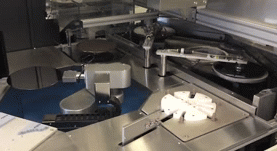May 2022 FAQ: Dicing and Die Prep
Integra provides quick-turn and volume die prep to many customers. Here are some of our frequently asked questions:
What does die prep encompass?
 Die prep encompasses all processes that take an IC from a wafer after test and into die form prior to assembly. Primary die prep processes are:
Die prep encompasses all processes that take an IC from a wafer after test and into die form prior to assembly. Primary die prep processes are:
- Backgrind
- Saw
- Pick
- Inspection
Wafer thinning, or backgrind, is the process of removing material from the backside of a wafer to a desired final target thickness.
What are the most common forms of backgrind?
The most common methods of wafer thinning are:
- Grind
- Wet etch
- Chemical Mechanical Planarization (CMP)
What kind of backgrind does Integra use?
Mechanical grind
What does microgrind or polish do to the wafer?
Die strength and smoothness can be increased based on grit/slurry selection (increasing smoothness), while also decreasing warpage and subsurface damage.
What are the most common types of wafer singulation?
The most common methods of wafer singulation are mechanical dicing are:
- Laser dicing
- Scribe and break
- Dice Before Grind (DBG)
What determines the best method for wafer singulation of my wafer?
Material type, wafer thickness, and street width are the most critical factors in wafer singulation when determining the optimal process method.
What are some keys when considering street widths of my wafer and subsequent dicing?
The following are keys when considering street width:
- A typical street width for mechanical dicing is in the neighborhood of 80um
- Street width governs the blade/kerf width
- Total thickness (including bumps) determines blade exposure
- Blade exposure is restricted by blade width
- The narrower the blade the smaller the exposure
- Therefore, for wafers with narrow streets, thinning is required
I have a multi-project wafer, what are some considerations?
- Indexing is consistent across all die in a reticle in order to singulate without sacrificing die
- Inconsistent indexing between die in a reticle would require die to be sacrificed or cut through, in order to salvage the target die
- If all die in an inconsistent reticle are required to be saved, then remounting is necessary
Have questions? Let us know: sales_inquiry@integra-tech.com

